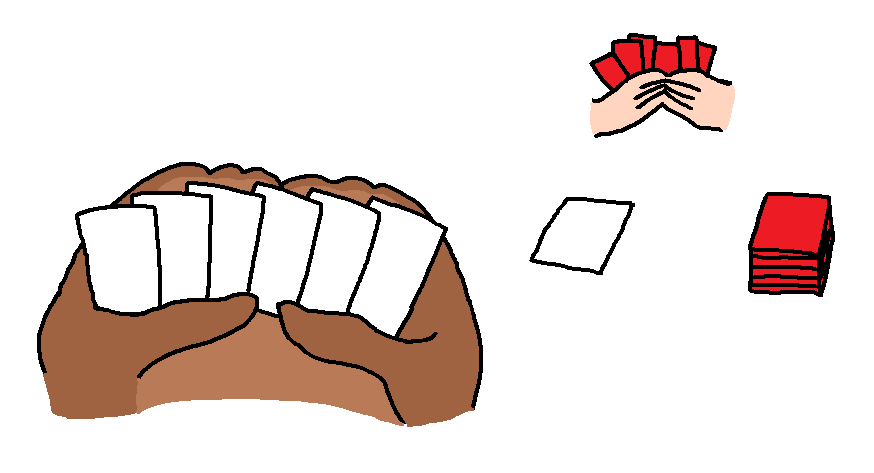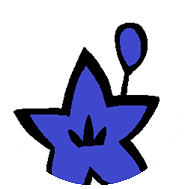Hiyoko (ひよこ, ‘chick’) is a Hanafuda sequence game for 2 players. It is also known as Shossho (しょっしょ).
This game was originally played using a mekurifuda deck called Ise: click here to see the rules using an Ise deck.
The game shares a similarity with Poka.
A variant of this game exists, called Isuri.
¶ Hanafuda Month Sequence
Unlike Poka which uses the standard month sequence, Hiyoko follows the Nagoya sequence.
You must be familiar with the Nagoya month sequence to play the game.
| # | Month | Icon | Flower |
|---|---|---|---|
| 1 | January | Pine | |
| 2 | February | Willow | |
| 3 | March | Cherry Blossom | |
| 4 | April | Wisteria | |
| 5 | May | Iris | |
| 6 | June | Paulownia | |
| 7 | July | Bush Clover | |
| 8 | August | Susuki Grass | |
| 9 | September | Chrysanthemum | |
| 10 | October | Maple | |
| 11 | November | Peony | |
| 12 | December | Plum Blossom |
¶ Setup
The game uses 45 cards from a standard Hanafuda deck. Remove all 3 Paulownia ![]() Chaffs from the deck before playing.
Chaffs from the deck before playing.
Players determine first who is the dealer. The dealer then shuffles the cards and deals 6 cards to each player, and 1 card on the table face up (this becomes the discard pile). The remaining cards are put on the table face down as the draw pile.

¶ Gameplay
Dealer plays first.
During a player’s turn, he/she looks at the topmost card in the discard pile, and then discards from his/her hand a card of the next month.
Example: There is a July ![]() card on the discard pile.
card on the discard pile.
Player must discard an August ![]() card.
card.
If the card on the discard pile is a December
card, you must discard a January
card.
After the player has discarded, he/she may also discard another card of the next month from the previously discarded card, and keep discarding until he/she doesn’t have a card in the month sequence.
Example: There is a July ![]() card on the discard pile.
card on the discard pile.
Player has an August ![]() , and September
, and September ![]() card in his/her hand.
card in his/her hand.
Player discards the August card, then the September card.
If a player doesn’t have a card of the next month in his/her hand, he/she passes his/her turn to the other player.
If both players pass their turn without discarding, the first player who passed draws one card from the draw pile and puts it on the discard pile at the start of his/her turn.
If the draw pile runs out of cards, form a new deck by taking all cards from the discard pile except for the top card. Shuffle the deck and put it back on the table face down.
¶ One-Two Combo
If the card on the discard pile is January ![]() , and you have both a January
, and you have both a January ![]() and a February
and a February![]() card in your hand, instead of just discarding the February card, you can discard the January card first before discarding the February card.
card in your hand, instead of just discarding the February card, you can discard the January card first before discarding the February card.
¶ Shapeshifting Cards
In Hiyoko, there are 10 Shapeshifting Cards (化札 [ばけふだ, bake-fuda]). These are considered special cards in the game.
The first five cards in the list can be counted as a Shapeshifting Card either in the hand or on the discard pile. They can be discarded if the top card on the discard pile is a month before any of the months assigned to the Shapeshifting Card. Also, if they are on the discard pile, They can be followed with a card of the next month from any of the months assigned to the Shapeshifting Card.
The next five cards in the list only count as a Shapeshifting Card when drawn from the draw pile. If it’s in your hand or if it’s discarded from a player’s hand, only the actual month on the card is counted.
¶ Winning the Round
During each round, the goal is to get rid of all the cards in your hand before the other player does. If you do, you earn 1 point, and become the dealer for the next round.
¶ End of the Game
First player to earn 3 points wins the game.
¶ Isuri (Hiyoko variant)
Isuri [いすり] is a Hiyoko variant for 2 players.
The rules are identical to Hiyoko, with some exceptions:
- 46 cards from a standard Hanafuda deck is used. Remove only 2 Paulownia
 Chaff. The remaining Paulownia Chaff is treated as a 2nd Phoenix card.
Chaff. The remaining Paulownia Chaff is treated as a 2nd Phoenix card. - The scoring system in Hiyoko, which is based on players discarding all of their cards, is replaced with a dynamic scoring system: A player gets paid immediately for each card they discard. (See Card Values below)
- If you pass the turn, you must place 1 point on the table as a Passing Penalty. The player who gets rid of all the cards in their hand takes all points from the Passing Penalty.
- You may discard 3 to 6 cards of the same month at once! You get paid for each of the cards discarded this way.
- If you manage to discard all 6 cards in your hand in one turn [総出し - そうだし, sou-dashi], you get 10 bonus points.
¶ Card Values
January = 10 pts.
Other months are worth points equal to their month number.
¶ Bibliography
- 渡部小童 著 - 『花札を初めてやる人の本』(土屋書店)
- Takeshi Ichinose, “新しい花札入門”
- Tanoshii Koto!, “ひよこの遊び方とルール”
- Japanese Wikipedia, “ひよこ (花札)”